The Indie Dev's Guide to grow your app
Mobile apps market is highly competitive and it's difficult to sustain your growth as an indie developer with limited resources. Check out different things we tried to grow Taskito to 300K+ downloads.
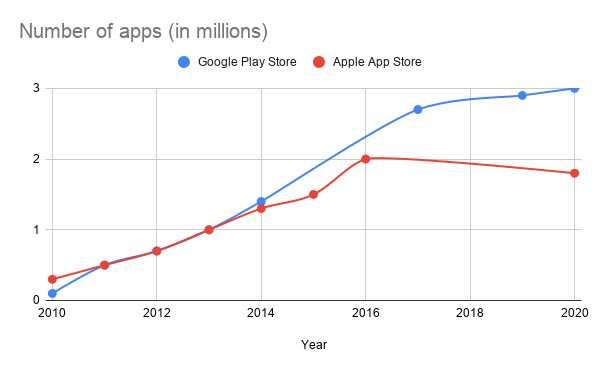
Source: iOS, Android
2010. Android & Apple phones have just started to enter the developing nations. There aren't many apps on the market – Great scope for indie developers to grow.
2020. Android & Apple phones are ubiquitous. The market is saturated with apps, barrier to entry is high and each niche has at least 50 apps.
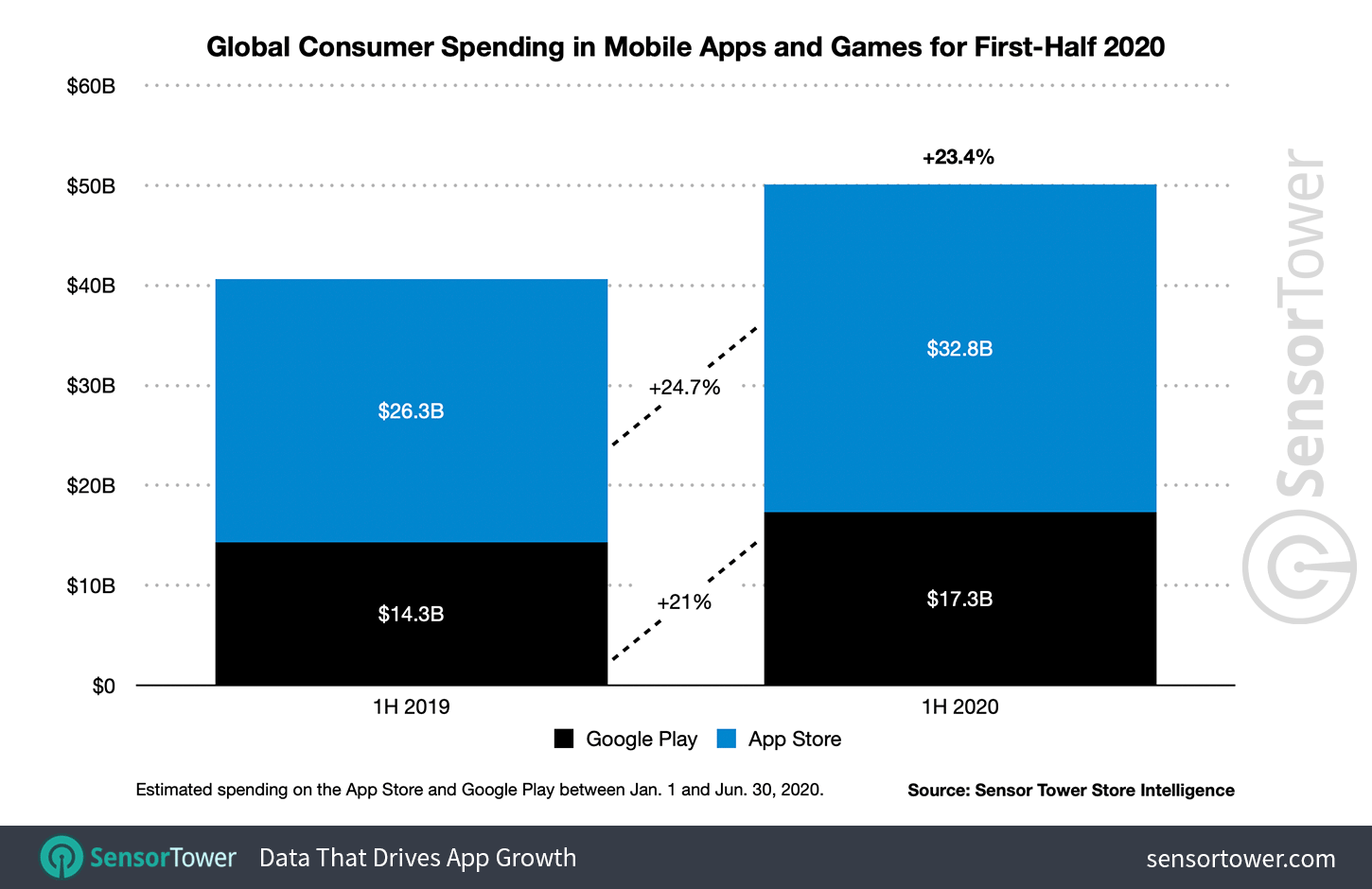
Source: Sensor Tower
It's difficult to enter the app store market & grow as an indie developer. Everyone wants cross-platform apps, sync, integrations and they expect it to be free.
Although there has been a surge in in-app purchases & subscriptions, it's a competitive market and you need a lot of resources to compete with the start-ups & big corps.
It's not impossible to be a successful indie developer. Many have aced and many are still in pursuit. There's no silver bullet to get more app downloads, but there are many possible solutions that you can try for free or with little resources.
When I started working on Taskito last year, it seemed like an impossible task - competing in one of the most popular spaces – To-do list & Productivity with the bigwigs (Todoist, TickTick, Microsoft To-Do) & hundreds of indie apps.
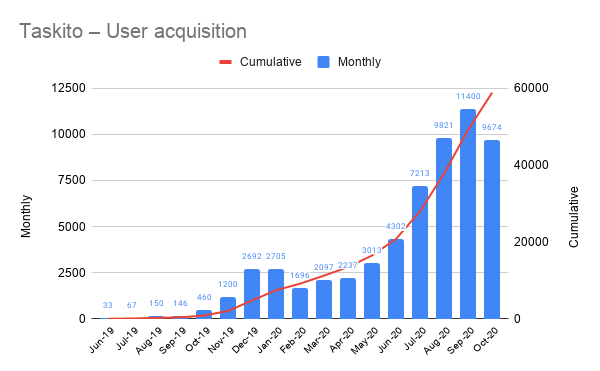
Taskito – User acquisition on Google Play
For the first 6 months, I wasn't actively doing anything to grow the app. With just over 1000 downloads and $12 in revenue, I wasn't feeling ecstatic. However, I had got some good quality feedback from reddit.
The app has achieved modest growth – crossing 50,000 downloads in 2020. It's not exemplary by any means. Very few indie apps launched in 2019 have crossed 50K mark in this category.
I am always trying to improve my knowledge & grow the app. In this journey, I have made some mistakes and learned a few things. I have written about it and these items are in no particular order.
- Validate your idea (Stage -1)
- MVP (Stage 0)
- Early adopters
- User feedback
- Ratings and reviews
- Translations
- Online presence
- Store listing, ASO & experiments
- Promotions (codes)
- Advertisements
- Influencers
- Conclusion
Validate your idea (Stage -1)
When you have an idea, don't rush. Look at the alternatives. Make a list of features you loved, features that surprised you, things that can be improved. Try to find what people are saying about the products.
💡 Discuss your ideas. Read The Mom Test and make sure you don't fall in the trap when people say they love your idea.
There are more ways to validate your idea
- Build a landing page – Measure bounce rate & email subscription rate.
- Add survey to the landing page, post on social media & get feedback.
Regretfully, I did not do this. I just created the app because I wanted something for myself. Had I done a proper idea validation, I would have added some features sooner.
MVP (Stage 0)
A Minimum Viable Product is a version of your idea that contains just enough features for early customers to provide you feedback & suggestion for the future development.
🏆 Build an MVP that actually adds value for the user.
A lot of people ignore these suggestions and it could lead to one of the following.
- Spend a lot of resources in building a full fledged product and ignore to validate market product fit. If it fails, it fails hard.
- MVP which does not add any value to the user. You may not get any constructive feedback which defeats its purpose.
I did an MVP and presented it to /r/androidapps. It just had one feature but there was some potential and people liked a fresh perspective which bagged me some feedback. I regret ignoring some of it as I wasn't ready to implement those features.
Early adopters
You have an MVP. You got validation & feedback. This is just the start of the journey.
📢 Get early adopters who will help you shape the product with iterative feedback. They will get you the initial traction by word of mouth. Empower them to be your product's advocate.
You can get early adopters from social media. Find app enthusiast groups or groups that fall in your niche / category. Promote your app and emphasizethat you are looking for feedback. As a general rule, don't spam.
Try to minimize the onboarding friction to get as many early adopters as possible.
- Optional sign up. A lot of people will bounce if they have to sign up.
- No subscription payments. It's an MVP.
- No ads. Ads don't generate any revenue for small scale. Keep the UX intact.
- No permissions unless absolutely necessary.
Reply to every feedback. Some people will put generic feedback - 'Nice app". Ask more information.
Although people have installed your MVP app, push regular updates to keep them interested.
User feedback
Getting iterative feedback is essential to develop the product. As an indie developer, we don't have the resources to run elaborate surveys, user research.
Some people will write to you or leave a review when they have a bad experience with the app. Very few will actually give actionable feedback. "The app is confusing" is a valid feedback but not actionable. It's anecdotal and not specific.
Write them back to get more details. Ask questions to get specific answers. If possible, set up a call to get more details.
Incentivize feedback
Less adoption leads to less feedback. How to get more people to give feedback?
💰 Incentivize the user to give feedback.
One way to incentivize them is to give promo codes for your app.
-
On the pricing / payments page, put a banner mentioning that you will provide promo code for in-app purchase in exchange of meaningful feedback.
-
Make promotional posts on social media - Promo codes in exchange of feedback.
* Core features should be accessible without payment (eg. free trial).
You will get tons of feedback. Some of it will be generic which you may ignore or reply to get more specifics. You will also get a lot of flattery just because they want codes. But there will be some genuinely actionable feedback.
If you don't have in app purchases, it may be difficult to incentivize the users. Perhaps, removing ads or rewarding them with some points that they can use.
Retain your early adopters
You have got some initial feedback. If you don't want this well to dry up, you need to keep interacting with your early adopters. Create a community – It could be a subreddit, Discord, Telegram or some other platform.
I created a subreddit. The interaction is below my expectations. I started a Telegram group for beta testers and I am getting plenty of feedback from there.
⚔️ User feedback is a double edged sword. People will suggest a lot of features. Don't fall into the feature creep trap. Validate each feature and decide what is essential and what is vanity.
Ratings and reviews
Social proof is a psychology technique that many products use successfully to get people to perform certain actions. For instance, we see messages such as "X people have bought this item today" on e-commerce apps. This technique makes people adapt their behavior based on experiences of others.
We should leverage this method to get more app reviews. The store already shows 3 pieces of social proof.
- Total number of downloads
- Average rating
- Total number of reviews
It's not possible to have higher number of downloads at start. But we must try to have higher rating than peers. As a rule of thumb, your app must have more than 4.6/5 rating.
Getting app reviews & ratings is not easy. People who liked your product may not leave a review. But when someone does not like your product, they will make sure that everyone knows about it. The system is biased towards poor ratings. The challenge is to get your happy customers to rate the app.
How to get more app reviews
-
Get friends & family to rate the app.
-
Prompt users to rate on the play store. Don't spam or interrupt the flow. Don't ask for rating for first few days. Let your customers have a few happy flows.
-
When you make a promotional post on social media, reply to every comment and ask them to support the app by leaving a review.
-
Whoever writes to you, ask them to leave a review. Add it in your email signature.
-
Make it easy for people to review. Put links everywhere.
-
When you provide a promo code, ask them to leave a review.
Growth hack your ratings & reviews. Set up milestones to reach 100, 500, 1000 reviews and work towards it.
📈 Higher rating & number of reviews act as social proof. These also contribute heavily to your rank on Play Store.

Taskito – Monthly ratings & average score
Translations
With only one language, you are not making it accessible to people from other countries / cultures.
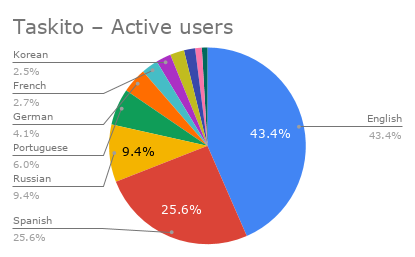
Taskito – Active users by languages
Once you have crossed 10K downloads, you should try to expand it to other languages. Find languages that would earn you the most users (and conversion) – English, Spanish, Russian, German & Portuguese are some of the top choices. This also depends on your target market and niche.
Machine translations are not perfect but it's a start. Once you plan to support more languages, you can get help from your early adopters or other people.
Crowdsourcing
You may not want to spend your little resources on a paid service or copy pasting everything manually. Get help. For Taskito, I have got offers from plenty of people to help translate the app in their mother tongues. And few do it on a regular basis.
I put a link in the app & the home page asking people to help with the translations.
Taskito is now available in 10+ languages and I manage everything with just Google Sheets & a python script to parse tsv and convert to xml resources. It takes some efforts to maintain it by yourself once the volunteers stop contributing. You will get more volunteers.
😇 People are inherently good and they will help you if you make them a part of the product. Involve volunteers in the process & recognize their efforts.
Online presence
A lot of indie devs may just stop at play store / app store listing and a landing page. Having a wide online presence is essential to improve SEO and build a community. A blog is a great way to talk about your product, compare other products and get those long tail keywords in.
Create a community for your users. Get your friends to follow your product and share occasional posts. Run a promotional campaign to gain followers. Post updates about what new features you are building. Do some customer support.
🔍 Online presence helps with SEO and builds your brand.
Store listing, ASO & experiments
Store listing is the most important part for organic growth in the initial stages. It is what essentially helps to increase app downloads. Having an optimized listing can put your app on the right path. There are 2 parts that you need to focus on.
- Search ranking
- Conversion rate
Search ranking
Keywords are influential in improving search ranking. This involves your title, small description, large description, developer name, text in reviews, backlinks. Use correct keywords based on your target audience.
App Store Optimization can be very frustrating. Changes don't have immediate effects. You will find a lot of generic articles to increase your ASO score, finding the right keywords, comparison with other apps, etc. You could try them and see if it helps you. I gave up after 2 months. This has proven to be a game-changer though.
Google keeps changing their search algorithm and this could have an impact on your search rank. It's a continuous process as other apps also keep improving their ranking.
Number of downloads, ratings & average score also contribute to your rank. So keep working on that.
Conversion rate
Once a user has landed on the store listing, you still want them to hit the install button. Icon, title, small description, screenshots will drive your conversions. Nobody reads the full description – It's just for keywords. A video helps with the conversion but I haven't made one yet.
Total downloads, high rating score & number of ratings help increase the conversion rate.
Get creative with your screenshots. You can also put mockups if they work better. Google Play guideline is to put only the screenshot (no frames, no background, etc). Don't do that. Even Google does not follow that. Check out screenshots of your peers and replicate if you are not getting the right results.
Experiments
Running an A/B experiment to see which screenshots / icon work better is a great way to increase conversion rate. These experiment also require a lot of visitors to prove a conclusive impact.
🧪 For a conversion rate of 30% with approx. 500 installs per day. It gives you 1500 visitors per day. To see a conclusive relative impact of 4%, you need to run the experiment for 31 days.
You can check your duration here – VWO or unbounce.
A/B testing your screenshots / logo will take a lot of time. You can not go with the newer version if you see it performing better for a few days. You must wait till your pre determined duration to decrease the likelihood of false-positives.
Promotions (codes)
Promotions are a great way to boost your installs, ratings & online presence. If your product does not support promotions, you can use Play Store / App Store promotion codes.
🆓 Use promotions to offer a free trial / part of the premium package. This will help understand them the value of your product and may convert them to paying customers.
- Provide promo codes to influencers / bloggers. It's the best way to get them to use your product for free. They may talk about it with their followers if they like it.
- Run promo campaigns on social media to gain more followers / early birds.
- Give codes for user feedback.
Advertisements
In today's digital world, ads have become cheap & accessible. Everyone uses ads to promote their products. It's not necessary to have a big marketing budget to run ads. You could always start small.
If you are new to this (like me), it could result in failed campaigns. I have tried Facebook, Instagram and Google ads. I don't have a lot of knowledge about keyword targeting, bidding process, etc. I tried. Few ad campaigns on Google with super low CPI bid got me hundreds of installs (but no paying customers).
📺 Ads could be a great tool to grow your product (if you do it right). Put some of your revenue aside as a marketing budget and get someone to help you.
Influencers
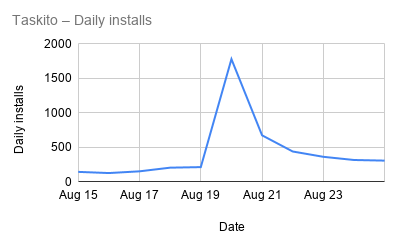
Taskito – Daily installs
Influencer marketing has a lot of potential to boost your product. I have not tried it but a famous Spanish Youtuber made a video about Taskito. It directly resulted in 3K downloads in 3 days and a lot of those became paying customers. It has a long term impact – few articles in Spanish blogs.
🗣️ Influencer marketing is expensive. But if you can get them to review your app, it's going to have a long term impact and the conversion is much better than cpc ads.
Conclusion
These are some of the things I tried to grow Taskito. ASO, Ads did not work as expected. It's a continuous process. Some of these may not work for your product. There are many things I haven't tried yet and some I don't even know if they exist.
Try, learn, iterate & grow!
TL;DR
👊 App stores are crowded. But you can grow your product even with little resources.
– Jay Rambhia
Download the app from PlayStore. Follow Taskito on social media for news & updates – Twitter & Facebook.
Related Articles
Feature rollout with Firebase remote config
Taskito used Firebase Remote Config feature to gradually rollout the cloud sync feature with percentage rollout mechanism. Here's how it went…
Android TopSheet - Implementation
Android Bottom Sheet Behavior explained and extended to create a Top Sheet component for Taskito. Read detailed analysis of behaviors and how to make a top sheet dialog.
Android: Views with custom states
Learn how to add custom view states in Android. This guide covers creating and managing custom drawable states using XML, improving UI consistency with custom state attributes, and enhancing your Android app's user experience.